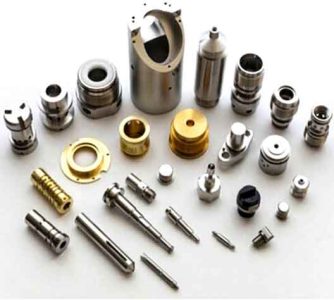Bewerking van draaiende delen
De ontwikkeling van draaicentra bestaat voor een aanzienlijk deel uit roterende onderdelen (iemand schat dat het ongeveer goed is 1/2). Naast draaien, bewerkingen zoals frezen, boren, en tikken zijn ook vereist. In aanvulling, de verwerkingstijd voor elk proces van het roterende lichaam is relatief kort. Daarom, het is dringend noodzakelijk om multi-processige verwerking van verbindingen uit te voeren op het roterende lichaam onder één klemming op een werktuigmachine, en ten slotte werd in de jaren zeventig een samengesteld draaicentrum ontwikkeld.
Vergeleken met gewone CNC-draaibanken, the turret tool post of the turning and milling center is equipped with power tools that can rotate the milling cutter, drill and tap. Tegelijkertijd, the machine tool spindle also has the C-axis function that can be accurately indexed according to the CNC program and interpolated with the X-axis or Z-axis. This 3-axis (X, Z, C) the control can be performed at a turning center of one clamping part turning body turning, frezen, boren, tikken. Dusver, it is still the most used composite machining machine tool for rotating parts in industrial production.

Bewerking van draaiende delen
Since then, the turning center has further developed in the direction of expanding the range of processing technology. In order to drill or mill holes or slots that deviate from the center line of the rotating body, a turret tool holder with Y-axis control has been developed. And correspondingly introduced a turning center controlled by 4 bijlen (X, Y, Z, C). Echter, hoe het draaicentrum met één spil het procesbereik ook uitbreidt, it still cannot solve the problem of the secondary machining of the back side of the rotating body under one clamping (dat is, the machining of the workpiece clamping end). Als gevolg, double-spindle turning centers appeared in the 1980s. Most of the two spindles of this machine tool are arranged oppositely on the same axis, so that after turning and processing the main end of the rotating body, de tweede spil pakt het werkstuk automatisch van de spil om het klemuiteinde te bewerken.
Omdat de bewerkingstaken van het klemuiteinde doorgaans relatief eenvoudig zijn, de tweede spil wordt gewoonlijk de subspil genoemd, en de kracht ervan is relatief klein. Het dubbelspillige draaicentrum kan worden uitgerust met één gereedschapspaal, maar de meeste zijn twee gereedschapspalen, in order to improve the processing efficiency and give full play to the potential of the machine tool. Axis of the body on the same side of the machine, equipped with mutually opposed spindles (18.65kW) and a secondary spindle (11kW). The speed of the two spindles is 0~4000r/min, en beide kunnen worden bestuurd door de C-as. The sub-spindle can also move along the axis to pick up the workpiece that has been machined on the spindle. A 10-tool turret tool post is provided above the main spindle and below the sub-spindle. Each tool position on the turret tool post can be equipped with a powered tool with a power of 3.7kW and a speed of 80-8000r/min. De bovenste gereedschapspaal wordt bestuurd door 3 bijlen (X1, J1, Z1), and the lower tool post is controlled by 2 bijlen (X2, Z2).
The rise of the turning center developed from the turning center. The 5-axis control (X, Y, Z, B, C) turning and milling center became a hot spot in the late 1990s. Not only has it further increased the B-axis control (to make the tool post rotate around the Y-axis), to drill and mill bevels. And instead of using the traditional turret tool post of the turning center, a high-speed and more powerful electric spindle tool post is used instead.
Since the electric spindle on the tool post can only be equipped with one tool at a time (the electric spindle is locked and does not rotate during turning), it is also equipped with an automatic tool changer and a tool magazine like a machining center. The milling and drilling capacity of this machine tool is equivalent to a small or medium-sized machining center. Its essence is to integrate a CNC lathe and a machining center, so it is named a turning-milling center.
The turning speed of the turning and milling center table is higher than that of the original machining center. Tegelijkertijd, de (elektrisch) spindle of the machine tool must be locked and a turning tool can be installed. The newly developed turning-milling center DMU80FD of German DMG company belongs to this type. The structure of DMU80FD is exactly the same as the company’s DMUP series machining center, and it has 5-axis and 5-face high-speed milling of the P series machining center. For all processing functions, the worktable of this machine adopts direct drive technology, the maximum speed is 500r/min, and the maximum speed of the machine tool spindle is also 2000r/min. Daarom, after the workpiece is clamped on this machine tool, 5-sided and 5-axis machining and compound machining from milling, boren, saai, tapping and turning can be realized efficiently.
 English
English العربية
العربية 中文(漢字)
中文(漢字) Čeština
Čeština Dansk
Dansk Nederlands
Nederlands Suomi
Suomi Français
Français Deutsch
Deutsch Italiano
Italiano 日本語
日本語 ಕನ್ನಡ
ಕನ್ನಡ 한국어
한국어 Português
Português Русский
Русский Slovenčina
Slovenčina Español
Español Svenska
Svenska Türkçe
Türkçe

